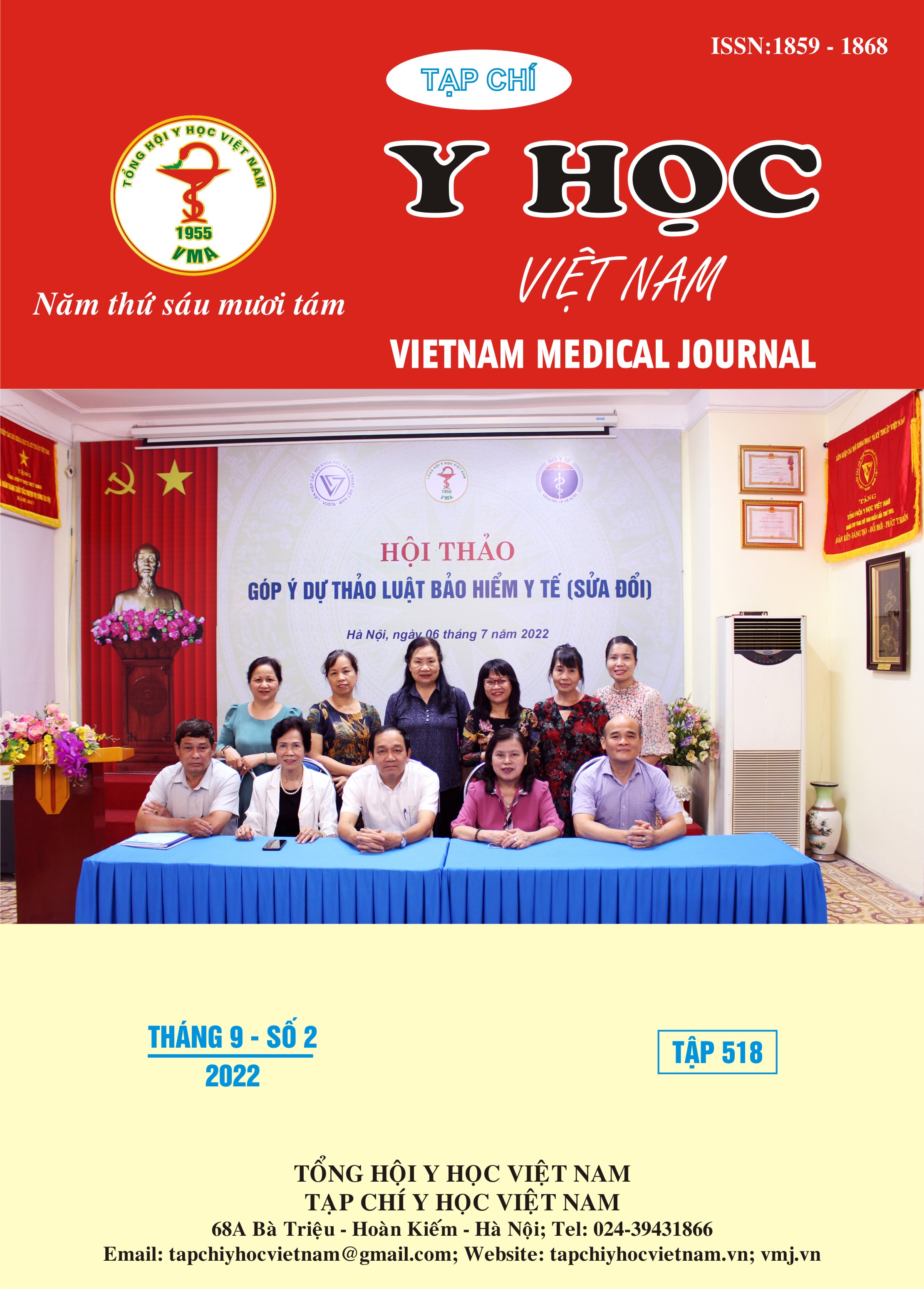BƯỚC ĐẦU NGHIÊN CỨU SỰ THAY ĐỔI NỒNG ĐỘ AMH TRÊN BỆNH NHÂN U NGUYÊN BÀO NUÔI CÓ BẢO TỒN TỬ CUNG ĐIỀU TRỊ METHOTREXAT TẠI BỆNH VIỆN PHỤ SẢN HÀ NỘI
Nội dung chính của bài viết
Tóm tắt
Mục tiêu: Sự thay đổi nồng độ AMH trên bệnh nhân u nguyên bào nuôi có bảo tồn tử cung điều trị Methotrexat tại Bệnh viện Phụ sản Hà Nội. Phương pháp nghiên cứu: Nghiên cứu mô tả tiến cứu trên 24 bệnh nhân được chẩn đoán u nguyên bào nuôi có bảo tồn tử cung điều trị đơn trị liệu Methotrexat tại Bệnh viện Phụ sản Hà Nội từ tháng 08/2021 đến tháng 04/2022. Kết quả: Tuổi trung bình của đối tượng nghiên cứu là26,7 ±4,93. Tất cả các bệnh nhân đều có điểm FIGO ≤ 4 và được điều trị bằng phác đồ MTX. Nồng độ AMH cơ bản tại thời điểm chẩn đoán là 3,1 ±1,57 ng/ml. Nồng độ AMH giảm sau mỗi đợt điều trị và có sự khác biệt đáng kể giữa AMH sau mỗi đợt điều trị hoá chất. Mức độ giảm AMH sau 3 đợt điều trị lần lượt là (47,4±24,98; 65,9±26,75 và 72,5±27,10). Kết luận: Nồng độ AMH tại thời điểm chẩn đoán có mối tương quan nghịch chặt chẽ với tuổi của bệnh nhân. Nồng độ AMH giảm nhanh và giảm mạnh sau khi điều trị hoá chất.
Chi tiết bài viết
Từ khóa
u nguyên bào nuôi, AMH, Methotrexat
Tài liệu tham khảo
2. Dezellus A, Barriere P, Campone M, et al. Prospective evaluation of serum anti-Müllerian hormone dynamics in 250 women of reproductive age treated with chemotherapy for breast cancer. Eur J Cancer Oxf Engl 1990. 2017;79:72-80. doi:10.1016/j.ejca.2017.03.035
3. Hamre H, Kiserud CE, Ruud E, Thorsby PM, Fosså SD. Gonadal function and parenthood 20 years after treatment for childhood lymphoma: a cross-sectional study. Pediatr Blood Cancer. 2012;59(2):271-277. doi:10.1002/pbc.23363
4. Solheim O, Tropé CG, Rokkones E, et al. Fertility and gonadal function after adjuvant therapy in women diagnosed with a malignant ovarian germ cell tumor (MOGCT) during the “cisplatin era.” Gynecol Oncol. 2015;136(2):224-229. doi:10.1016/j.ygyno.2014.12.010
5. Hansen KR, Hodnett GM, Knowlton N, Craig LB. Correlation of ovarian reserve tests with histologically determined primordial follicle number. Fertil Steril. 2011;95(1):170-175. doi:10.1016/j.fertnstert.2010.04.006
6. Practice Committee of the American Society for Reproductive Medicine. Testing and interpreting measures of ovarian reserve: a committee opinion. Fertil Steril. 2015;103(3):e9-e17. doi:10.1016/j.fertnstert.2014.12.093
7. Anderson RA, Themmen APN, Al-Qahtani A, Groome NP, Cameron DA. The effects of chemotherapy and long-term gonadotrophin suppression on the ovarian reserve in premenopausal women with breast cancer. Hum Reprod Oxf Engl. 2006;21(10):2583-2592. doi:10.1093/humrep/del201
8. Bi X, Zhang J, Cao D, et al. Anti-Müllerian hormone levels in patients with gestational trophoblastic neoplasia treated with different chemotherapy regimens: a prospective cohort study. Oncotarget. 2017;8(69):113920-113927. doi:10.18632/oncotarget.23027
9. Nguyễn Thái Giang. Kết quả điều trị u nguyên bào nuôi nguy cơ thấp tại Bệnh viện Phụ sản Trung ương. Tạp Chí Nghiên Cứu Học. 2019;Tập 121(Số 5):23-30.
10. Bi X, Zhang J, Cao D, et al. Anti-Müllerian hormone levels in patients with gestational trophoblastic neoplasia treated with different chemotherapy regimens: a prospective cohort study. Oncotarget. 2017;8(69):113920-113927. doi:10.18632/oncotarget.23027


